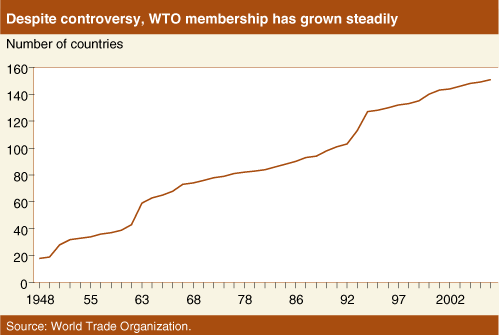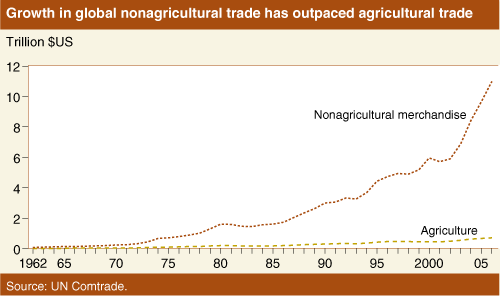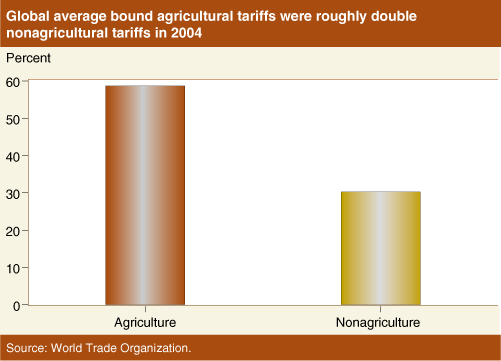World Trade Organization and Globalization Help Facilitate Growth in Agricultural Trade
- by Anne Effland, Mary Anne Normile, Donna Roberts and John Wainio
- 6/1/2008
Highlights
- Despite the WTO having strong critics in the U.S. and abroad, membership in the organization continues to grow.
- WTO member countries trade concessions to gain access to foreign markets, benefiting producers and consumers in the aggregate.
- The growth of the WTO has helped facilitate the globalization of agriculture.
In simple terms, globalization refers to the closer integration of countries and people around the world. It is the product of numerous factors, including reduced trade barriers, lower transportation and communication costs, and increased movements of capital, knowledge, technology, culture, and people across borders. To many, these changes imply progress, but globalization is an issue of multiple dimensions that has sparked heated debates and protests around the world.
Proponents argue that globalization results in increased consumer choices and access, enables countries to use resources more efficiently, leads to the introduction of new technologies, creates new industries, and promotes more rapid economic growth.
Critics maintain that globalization has exposed vulnerable economies to economic and financial shocks not of their making, contributed to environmental degradation, led to unemployment and downward pressure on wages, and strained the ability of poor countries to adapt.
In recent years, the World Trade Organization (WTO) has become a focal point of the globalization controversy, largely due to its visible role in reducing barriers to trade in goods and services. The massive protests at the 2001 WTO meeting in Seattle took many by surprise and thrust both globalization and the WTO into the world spotlight.
Critics of the WTO are not limited to anti-globalization protesters; proponents of free trade and globalization have also criticized the WTO. Some see the 7-year long negotiation of a new multilateral trade agreement as evidence that too many countries are unwilling to reach the compromises needed. Others cite the differences in expectations for developed and developing countries as a sign that the WTO is not even-handed. Still others see unacceptable threats to vulnerable industries and even to national sovereignty resulting from the disciplines required for membership.
Yet, since 1948, when the WTO’s predecessor, the General Agreement on Tariffs and Trade (GATT), was launched, membership has grown from 23 to 151 countries. Another 30 countries hold observer status while they wait to become members. Given the criticism of the organization, why have so many countries joined?
Countries Seek Gains From Reciprocal Concessions
Countries join the WTO for many reasons, but largely to increase trade, and, in particular, exports. One of the key contributions of economics has been its demonstration that countries can mutually benefit from trade. In its simplest form, if country A produces wheat and country B produces coffee, both can improve citizens’ welfare by exchanging wheat for coffee. Through the price system, which establishes values for the exchange of multiple commodities, the process can be extended to accommodate an infinite variety of goods.
This simple yet powerful concept is behind much of the trend toward globalization and has motivated countries to negotiate trade agreements. Trade negotiations basically involve reciprocal concessions—exchanges of tariff cuts or other grants of comparable value that enable this mutually beneficial exchange of goods. A primary reason countries engage in trade negotiations is to increase access to foreign markets for their products. Granting access to foreign producers is seen as a necessary cost of gaining access to other markets. However, reducing trade barriers also can facilitate growth and benefit the overall economy by enabling a country to use its resources more efficiently.
The benefits of reciprocal trade concessions extend beyond the increased exports valued by producers: consumers also gain from concessions that lower the cost of imports. Trade policies, like tariffs, that raise the cost of imports essentially act as taxes on consumption. Lower tariffs and quotas, for example, have reduced the cost of many clothing items for U.S. consumers. Lower tariffs have also helped make a wider variety of fresh produce available to U.S. consumers during winter months. When economists measure the benefits of trade agreements, they include both the value of increased exports and the increase in well-being of consumers that comes from paying lower prices.
Countries also seek membership in the WTO as a way to increase their potential for achieving economic growth and increased prosperity. For the generation of policy officials who witnessed the effects of protectionist policies on world economies during the Great Depression, the connection between trade and economic growth was clear. To remedy the policy mistakes of the 1930s and preceding decades, trade officials negotiated the 1947 GATT to lower barriers to international commerce and establish a charter setting out the broad principles that should govern trade policies.
Chief among these principles were the Most Favored Nation (MFN) and national treatment provisions. MFN mandated that importing countries would not be allowed to treat the same goods from the signatories of the GATT differently. National treatment mandated that imported goods should face the same regulatory standards as those imposed on the domestic goods of a member country. Both provisions convey powerful advantages to countries seeking access to foreign markets. Because of the MFN provision, a country joining the WTO today immediately qualifies for all the tariff concessions previously negotiated by members.
In the early years of GATT, membership meant participating in negotiations to reduce high tariffs that had restricted trade and led to economic hardship. Negotiations were conducted bilaterally and focused on the tariffs each country would like the other to reduce. Because the bilaterally negotiated concessions would be available to all GATT members through the MFN provision, other countries could balance those benefits against concessions they might be asked to make. For example, the U.S. could agree to cut a tariff on an import from another country even if it was not completely offset by an equivalent tariff cut by that country because the U.S. already expected to benefit from a tariff cut that country had negotiated with a third country.
As the membership in the GATT expanded, however, negotiators found it increasingly difficult and time consuming to complete bilateral deals. As a result, negotiations today follow a formula approach of across-the-board cuts. Deals among a large number of participants still offer countries the opportunity for balancing benefits against concessions.
WTO Provides the Framework for Rule Enforcement
In addition to providing a forum for trade negotiations, multilateral trade agreements like GATT and the WTO extend a consistent set of rules to many countries at once. Countries agree to rules of trade that may limit their own policy flexibility because the rules impose discipline on the trade policies of other members—all countries accept some pain to realize gains.
The expectation that the rules of trade apply to all members of the multilateral agreement underlies reciprocal concessions. Each member is protected from rules violations by others. If one country raises a tariff above its agreed (or bound) ceiling level, for example, the injured country may be due compensation. This may come in the form of tariff reductions on other products or other trade concessions equal to the level of damage from the violation. The enforceable threat of retaliation embedded in reciprocal agreements creates a powerful incentive for members to comply with their obligations.
The original GATT system lacked a strong means of enforcing rules violations. Its dispute settlement process, which required consensus, allowed an importing country to unilaterally block trade complaints. Creation of the WTO provided the institutional framework to support a more effective dispute settlement process by providing measurable recourse to countries whose rights have been violated.
Adding to the original GATT rules, the WTO’s Agreement on Agriculture and Agreement on the Application of Sanitary and Phytosanitary (SPS) Measures set out important provisions for governing trade in agricultural products. If issues related to a policy’s compliance with trade rules cannot be resolved in bilateral discussions, countries can appeal to WTO committees that oversee the implementation of each individual agreement. For example, the Committee on Agriculture reviewed 155 notifications from members documenting their policies for market access, domestic support, and export subsidies in 2006. Likewise, the SPS Committee has provided a forum for airing grievances and made it easier to identify and track contentious regulations. The committee reports that one-third of the 245 “special trade concerns” identified by members over the past 12 years have been fully or partially resolved through consultations. The committee also has facilitated dispute resolutions between countries at every level of development.
Additional WTO dispute settlement mechanisms for resolving conflicts include adjudication by a WTO panel and the WTO Appellate Body, if required. If a disputed measure is found to violate WTO provisions, the parties to the dispute may request arbitration to determine a “reasonable period of time” for the respondent to change its policy or, if it does not, to determine the amount of compensation or retaliation due to the complainant (usually in the form of tariff adjustments on other products).
The WTO has also facilitated communication and transparency in the trading system and helped to resolve disputes before they reach formal settlement proceedings. A strengthened requirement for transparency is among the important institutional changes brought about in the transition from GATT to WTO. Country “notifications,” or reports to the WTO of proposed changes in policies or regulations that could adversely affect trade, are key to enabling judgment about the purpose, design, or effect of a policy or measure. WTO notification is now routine for all member countries. For example, members submitted more than 8,000 notifications related to SPS measures between 1995 and 2007, compared with fewer than 80 between 1980 and 1990.
The evidence indicates that these notifications spawned a broad-based “regulatory review,“ as major agricultural importers and exporters began to assess whether they and their trading partners were complying with the SPS Agreement. As a result, several measures restricting trade in fruit and vegetables were unilaterally revised following technical consultations. For example, Japan agreed to rescind its 46-year-old ban on several varieties of tomatoes grown in the United States based on scientific research indicating that the tomatoes were not afflicted with tobacco blue mold disease. New Zealand officially recognized that treating fruit with hot forced air was equivalent to spraying with a prohibited fumigant, thereby allowing several South Pacific countries to resume exports of mangos, papaya, and eggplant.
WTO Helps Facilitate Globalization of Agriculture
Under GATT, and more recently through the WTO, member countries have reduced tariffs on manufactured goods to exceptionally low levels, facilitating a steady increase in trade in manufactured goods since the 1950s. Global trade in agricultural products, however, has grown much less rapidly since then for a number of reasons, including the continued protection of agriculture by many countries. The body of rules established to govern merchandise trade made numerous exceptions for agricultural goods. One of the most important accomplishments of the Uruguay Round (1986-94) is that it succeeded in incorporating agriculture into the multilateral trade rules. Yet, agricultural trade continues to be influenced by a legacy of high protection and government intervention (see “Why Agriculture Was Treated Differently Under GATT”). Tariffs on agricultural products remain significantly higher, on average, than tariffs on manufactured goods.
Despite higher protection on agricultural trade, a number of factors have led to its growth over the past 40 years. Improvements in transportation and handling, such as containerization and refrigeration, have facilitated shipments of out-of-season produce from distant origins, something not possible 20 years earlier. Communication and logistical improvements have enabled shippers of bulk agricultural commodities, like grains, to respond more easily to market demands for specific types, grades, and qualities. Greater purchasing power among developing countries, which tend to spend a higher share of increased income on food, has also contributed to growth in agricultural trade. These developments have been complemented in recent years by the reductions in barriers to agricultural trade brought about through the Uruguay Round Agreement on Agriculture as well as through bilateral and regional agreements.
Globalization of agriculture can bring positive benefits for developing countries. Reduced global tariffs on processed products may fuel economic development by encouraging developing country exports of these products, allowing them to benefit from the employment and value-added benefits associated with domestic processing. Greater trade opportunities also may expand markets for their goods, making investment more attractive. Reducing subsidies also can help developing countries by encouraging shifts of resources to more efficient uses, in agriculture or other sectors.
Successive rounds of multilateral trade liberalization, however, have revealed the difficulties that many low-income countries face in capturing the benefits of more open markets. In these countries, governments, institutions, and enterprises often lack capacities—in the form of information, policies, procedures, and infrastructure—to compete effectively in global markets and take full advantage of the opportunities that are offered through international trade. To help these countries overcome their trade-related institutional, human resource, and supply capacity constraints, WTO members have agreed on steps to improve implementation of the current agreements. These initiatives include increased technical and financial assistance in trade policy and regulations, trade development, and economic infrastructure.
Furthermore, in order to ease the adjustment pressures brought on by trade liberalization, developing countries are granted special and differential treatment within the WTO. In particular, developing countries are asked to make smaller cuts in tariffs than those for developed countries and are given a longer period of time to phase in the cuts. In addition, all countries have access to safeguard measures that allow them to temporarily restrain trade when their producers are threatened with serious injury as a result of imports.
Critics of the WTO have pointed to other limitations of the multilateral trading system, including the lack of agreements on environmental protection, labor standards, investment issues, and e-commerce. At the same time, the WTO has been attacked for tackling these other questions, which some consider peripheral to an agreement on trade. Attempts have been made to address some of these concerns in other forums, but these issues continue to be raised and are increasingly linked to globalization. The WTO may be further pressed to find a balance between what it views as its mandate to deal solely with trade rules and some of its members’ views that through its trade rules, the WTO can make a contribution to addressing problems in other areas.
You may also like:
- Wainio, J., Shapouri, S., Trueblood, M. & Gibson, P. (2005). Agricultural Trade Preferences and the Developing Countries. U.S. Department of Agriculture, Economic Research Service. ERR-6.
- Burfisher, M.E., Diao, X., Elbehri , A., Gehlhar, M., Gibson, P., Leetmaa, S., Mitchell, L., Nelson, F.J., Nimon, R.W., Normile, M.A., Roe, T., Shapouri, S., Skully, D.W., Smith, M. & Somwaru, A. (2001). The Road Ahead: Agricultural Policy Reform in the WTO--Summary Report. U.S. Department of Agriculture, Economic Research Service. AER-797.
- Global Agriculture and the Doha Round: Market Access Is the Key. (2006). Economic Research Service. in Amber Waves..
We’d welcome your feedback!
Would you be willing to answer a few quick questions about your experience?




